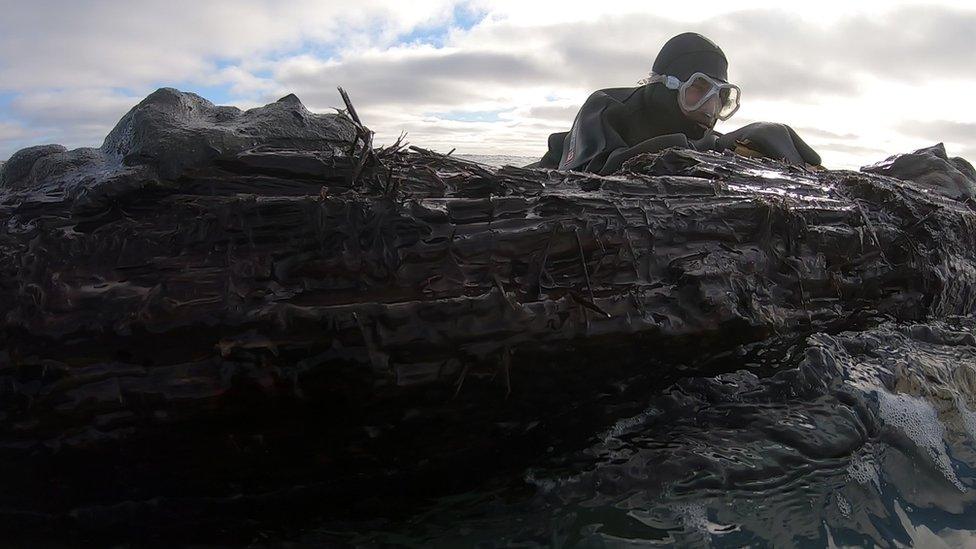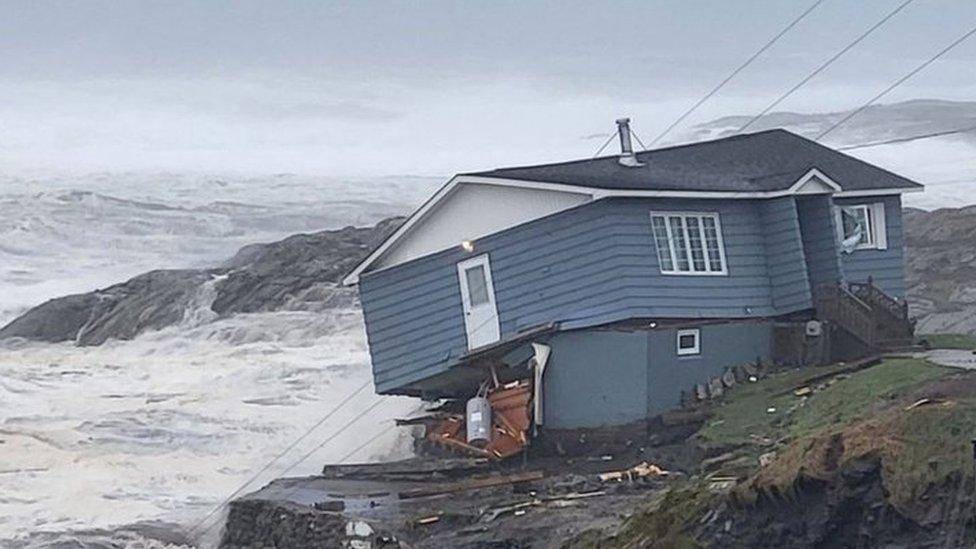Canada shipwreck: Newfoundland locals try to solve Cape Ray mystery
- Published
Watch: Mysterious shipwreck washes up on Canadian coast
A mysterious shipwreck that washed up on shore in Newfoundland, Canada, has captured the imagination of locals.
Wanda Blackmore said her son was hunting sea ducks when he stumbled upon "a dark object out in the water".
That object was a 24m-long wooden ship that likely dates back to the 19th Century.
Locals think the wreck could be a vital piece of Newfoundland history, and experts now intend to uncover what it was before it met its watery grave.
"It could be the ship that brought my ancestors, or my husband's ancestors," said Ms Blackmore, who has English, Irish and Scottish roots.
A team of archaeologists will survey the wreck on Saturday to gather clues on when this particular ship may have been built and why.
The team has to work quickly, as there are fears that strong waves could pull the ship away from the coast and towards deeper waters. They also have to get out there while the tide is still low.
Their process involves measuring the timbers to estimate its original size, as well as trying to determine the age of the trees used to build it, said Neil Burgess, president of the Shipwreck Preservation Society of Newfoundland and Labrador.
"I am hoping we'll be able to figure out more and more of the story, and to be able to piece together where this ship came from and how it ended up here, " Mr Burgess said.
It is familiar work for this team of experts.
Jamie Brake, Newfoundland's provincial archaeologist, said the island has seen countless shipwrecks over the years.
"We live on an island that has a major seafaring history," Mr Brake said.
The wreck appeared on the shores of the small coastal town of Cape Ray on the south-west coast of the island of Newfoundland. Only about 250 people live in Cape Ray, which looks over a rugged part of the Atlantic, with large, shallow rocks that have destroyed dozens of ships since the 1800s.

A team of experts have been surveying the ship's wreckage in hopes of uncovering clues about its origin
Some believe that powerful Hurricane Fiona, which in September 2022 travelled north from the Caribbean and through the Atlantic Ocean before hitting Canada, may have helped dislodge the ship from the ocean floor.
It is the many unknowns around the ship, however, that have captured the province's imagination and caused many to regularly travel to the site to take pictures with the wreck.
Bert Osmond lives in the area and told the Canadian Press that he visits the ship regularly to make sure it has not been washed away by the powerful tide.
"A lot of people's concern is we don't want it to go back out to sea," he told the Canadian news outlet. "If it goes back out to sea, we're not going to know nothing."
That thirst for information has driven many to connect the ships origins to their own, with some wondering if it may have been carrying immigrants from Great Britain or Ireland over to Canada.
Ms Blackmore said many of the residents in Cape Ray can trace back their ancestors' roots in the area to as early as the 18th Century.
The vast majority of Newfoundlanders and Labradorians - about 90% - are descendants of people who came from the British Isles between the early 17th century and the late 19th century.
This resettling was rooted in a seasonal, trans-Atlantic migratory cod fishing tradition that lasted for centuries.
Mr Osmond said that seafaring history means that many in the region feel a special connection to the ship and the history it may hold.
"I was amazed with her, and I still am," he said.

You may also be interested in

Related topics
- Published31 January 2024

- Published28 November 2023

- Published27 September 2022
